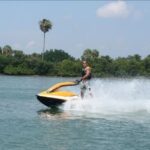Cruising over a frozen white landscape is part of the romanticism of cross-country skiing. But having the wrong style or size of ski can turn that romantic dream in to a nordic nightmare. So before heading out to the store, a little knowledge of what you are looking for will go a long way.
As far as skis go, there a couple types of skis you can get based on your skiing style. If you are a regular nordic skier, then you would generally be found cruising around on groomed or track-set terrain, usually on or around local ski hills or parks. Nordic skis can come in a few subcategories but are generally fairly thin skis, have no metal edges, and can come with waxable or even waxless bases. Classic skis are the most common cross-country ski and dominate the ‘nordic’ style of ski. If you envision the stride-and-glide motion while thinking of a cross-country skier then that person would be wearing Classic skis. Skating skis are another type of popular Nordic ski. This is a more aerobic form of cross-country skiing and has an angled skating motion. Skate skiing can only be performed on wide groomed areas at your local cross-country ski areas. You can also get high-performance nordic skis, and these can be either skate or classic skis. Generally lightweight, stiff, and thinner than recreational classic or skate skis, these skis are built for the advanced skier looking for speed during competitions. If getting away from the crowd and breaking your own trail is more your thing, then you may wish to opt for Backcountry Touring skis. These skis are made for people who ski on ungroomed trails and like to venture anywhere as long as there is snow. Backcountry Touring skis are generally wider and stiffer then regular nordic skis, made this way to handle the load of a backpack and to float on the snow where there is no set track. As well, Backcountry Touring skis also have full metal edges to aid in traversing and descending hilly terrain.
Cross-country skis use a different sizing formula than downhill skis. Classic skis should be taller than yourself. A general rule to size Classic cross-country skis is to multiply your height in inches by 2.6 and then add 25 to the result to get the ski length in CENTIMETERS. For skate skis, they should generally be 5 to 10 cm’s taller than yourself. You’ll also have to weigh yourself and while in the store, have a customer service rep help you ‘weight’ the ski. Different skis have different curvature and stiffness it’s extremely important to choose the proper ‘weight’ to enjoy your skiing. The curve of a ski helps keep the gliding portion of the ski on the snow. But you need the ski to bend and straighten out when you kick so that you can engage the sticky part of the ski (under your foot) with the snow for traction to kick. Too much stiffness and you will never get a kick and you’ll be sliding all over the place and hurting your hips. Too little stiffness in the ski and it will sit flat and you sticky kick wax will never leave the surface of the snow and you won’t glide. Having a store rep help you find the proper weight to your ski is crucial.
Speaking of wax, you can choose between a waxless ski or a waxable ski. Having waxable skis are ideal for most cross-country skiers. Waxable skis are usually smoother and faster than any waxless ski, especially in consistently cold temperatures. The do become a challenge in wet coastal environments. Waxless skis are virtually maintenance free. They have a textured pattern where the ‘kick’ wax would normally go on waxable skis to provide a grip on the snow. They don’t perform as well as waxable skis but are great for the casual skier who just want to get out and ski without the worry of waxing and setting up their skis for the weather.
As for bindings, they must be matched to your boot as interchangeable systems to do not exist with bindings and boots. Your bindings connect the tip of the ski boot to your ski. There are three main types of cross-country ski binding but all do the same function, they hold the toe of your boot to the ski. NNN bindings are extremely common and can be used for both classic and skating techniques. SNS Profil come in skate and classic versions and are very popular with Salomon boots. 3-pin bindings are the traditional binding for backcountry skis. A lot of the beefier backcountry boots use the 3-pin style binding mechanism. The best route for choosing you binding is to choose your boots first, and then see what binding system works with those boots. Bindings are generally personal preference so choosing a boot that feels right first, then matching a binding to the boot is probably the most comfortable way to go.
Carry this knowledge with you to the store and you’ll get fitted with the right gear that matches you skiing style. That way you’ll have maximum fun when the snow begins to fall this winter.



